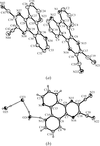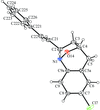issue contents
September 2008 issue

Cover illustration: A magnified view of the one-dimensional chain of hydrogen bonds of 1-naphthylammonium iodide. Only the C atoms to which the N atoms are attached are shown. The schematic shows the four different hydrogen-bonded rings forming a distorted cube. See Lemmerer, Billing & Robinson [Acta Cryst. (2008), C64, o481-o484].
inorganic compounds
Download citation


Download citation


The crystal structure of hydrothermally grown CaTe2O5 is made up of undulating 2∞[Te2O5]2− layers propagating parallel to (100) with the TeIV atoms in fourfold coordination. Adjacent layers are linked by distorted [CaO7] polyhedra along [100].
Download citation


Download citation


The title compounds belong to the apatite family. Suitable single crystals were prepared under hydrothermal conditions. All three structures consist of isolated slightly distorted AsO4 tetrahedra which are bridged by Sr2+ in Sr5(AsO4)3F, by Sr2+/Ba2+ in (Sr1.66Ba0.34)(Ba2.61Sr0.39)(AsO4)3Cl and by Cd2+ in Cd5(AsO4)3Cl0.58(OH)0.42.
metal-organic compounds
Download citation


Download citation


Download citation


Download citation


Download citation


Download citation


Download citation


Download citation


organic compounds
Download citation


Download citation


Download citation


Download citation


Download citation


Download citation


Open  access
access
 access
access Download citation


Download citation


Download citation


Download citation


Download citation


Download citation


Download citation


Download citation


Download citation


Download citation


Download citation


Download citation


Download citation


Download citation


Download citation


Download citation


Download citation


Download citation


Download citation


Download citation


Download citation


Download citation


Download citation


Download citation


Download citation


Download citation


Download citation


Download citation




 journal menu
journal menu








































